Practice Question - 77 (Scheduling) | 100 DILR Questions for CAT Preparation PDF Download
Comprehension:
A, B, C, D, E and F are the six police stations in an area, which are connected by streets as shown below. Four teams - Team 1, Team 2, Team 3 and Team 4 - patrol these streets continuously between 09:00 hrs. and 12:00 hrs. each day.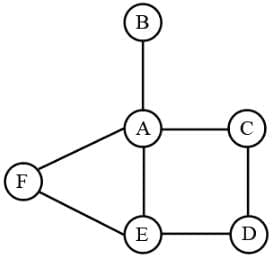 The teams need 30 minutes to cross a street connecting one police station to another. All four teams start from Station A at 09:00 hrs. and must return to Station A by 12:00 hrs. They can also pass via Station A at any point on their journeys.
The teams need 30 minutes to cross a street connecting one police station to another. All four teams start from Station A at 09:00 hrs. and must return to Station A by 12:00 hrs. They can also pass via Station A at any point on their journeys.
The following facts are known.
- None of the streets has more than one team traveling along it in any direction at any point in time.
- Teams 2 and 3 are the only ones in stations E and D respectively at 10:00 hrs.
- Teams 1 and 3 are the only ones in station E at 10:30 hrs.
- Teams 1 and 4 are the only ones in stations B and E respectively at 11:30 hrs.
- Team 1 and Team 4 are the only teams that patrol the street connecting stations A and E.
- Team 4 never passes through Stations B, D or F.
Q1: Which one among the following stations is visited the largest number of times?
(a) Station C
(b) Station E
(c) Station D
(d) Station F
 View Answer
View Answer 
Ans: (b)
It is given that none of the streets has more than one team traveling along it in any direction at any point in time (point 1), which implies at 9:00 hrs, all 4 teams have chosen different routes from the starting point.
It is also known that Teams 2 and 3 are the only ones in stations E and D respectively at 10:00 hrs, and Team 1 and Team 4 are the only teams that patrol the street connecting stations A and E.
It is only possible when Team 2 traveled (A - E) via F, and Team 3 reached station D via station C.
It is also known that Teams 1 and 3 are the only ones in Station E at 10:30 hrs, and Team 4 never passes through Stations B, D, or F. Hence, Team 1 must have chosen the (A-B) route at the starting point, and Team 4 has chosen the (A - E) root at 9:00 hrs.
Hence, Team 1 will reach B at 9:30, and come to A at 10:00 hrs. After that, they will go to E at 10:30 hrs.
Since Team 4 never passes through stations B, D, or F. Team 4 only can pass through stations A, E, and C.
Hence, the routes of team 4 to reach station E at 11:30 will be (A - E - A - C - A - E) or (A - E - A - E - A - E).
Since team 1 is already traveling to E from A at 10:00 hrs, at that time team 4 can't choose the same route. Hence, the final route for team 4 to reach E at 11:30 is (A - E - A - C - A - E), and at 12:00 hrs, team 4 will come back to station A.
Hence, the complete route diagram for team 4 is (A - E - A - C - A - E - A)
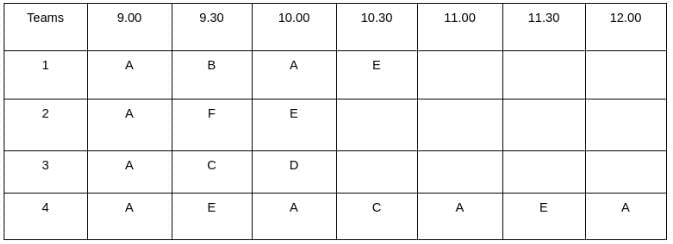
We can see that team 1 is at station E at 10:30 hrs, and they will reach station B at 11:30 hrs, which is only possible when they travel to B via A.
Hence, the complete route diagram for team 1 is (A - B - A - E - A - B - A). It is also known that Teams 1 and 3 are the only ones in station E at 10:30 hrs.
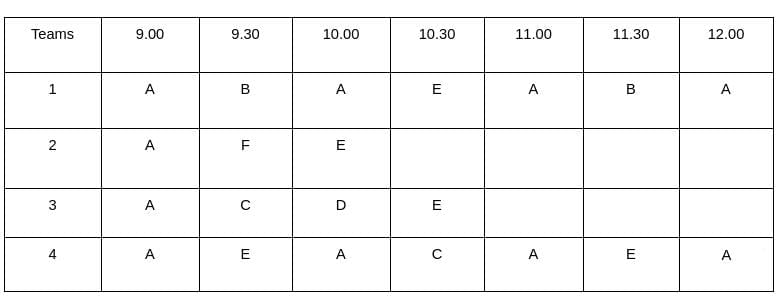
The only possible root for Team 2 at 10:00 hrs. is from E to F since they can't choose E to D because Team 3 is already on this route. Since team 3 has to reach A at 12:00. The only possible combination for team 3 is E - D - C - A
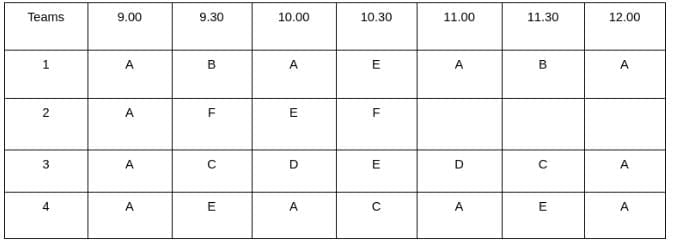
Now the routes for team 2 going back to A is from F at 10:30 hrs. (F - A - F - A) or (F - E - F - A).
Hence, the final table is given below:
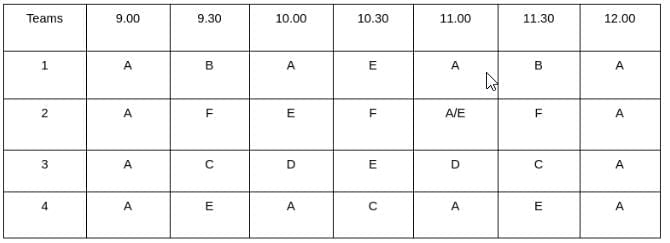
From the table, we can see that among the options station E is visited the largest number of times.
Q2: How many times do the teams pass through Station B in a day?
 View Answer
View Answer 
Ans: 2
It is given that none of the streets has more than one team traveling along it in any direction at any point in time (point 1), which implies at 9:00 hrs, all 4 teams have chosen different routes from the starting point.
It is also known that Teams 2 and 3 are the only ones in stations E and D respectively at 10:00 hrs, and Team 1 and Team 4 are the only teams that patrol the street connecting stations A and E.
It is only possible when Team 2 traveled (A - E) via F, and Team 3 reached station D via station C.
It is also known that Teams 1 and 3 are the only ones in Station E at 10:30 hrs, and Team 4 never passes through Stations B, D, or F. Hence, Team 1 must have chosen the (A-B) route at the starting point, and Team 4 has chosen the (A - E) root at 9:00 hrs.
Hence, Team 1 will reach B at 9:30, and come to A at 10:00 hrs. After that, they will go to E at 10:30 hrs.
Since Team 4 never passes through stations B, D, or F. Team 4 only can pass through stations A, E, and C.
Hence, the routes of team 4 to reach station E at 11:30 will be (A - E - A - C - A - E) or (A - E - A - E - A - E).
Since team 1 is already traveling to E from A at 10:00 hrs, at that time team 4 can't choose the same route. Hence, the final route for team 4 to reach E at 11:30 is (A - E - A - C - A - E), and at 12:00 hrs, team 4 will come back to station A.
Hence, the complete route diagram for team 4 is (A - E - A - C - A - E - A)
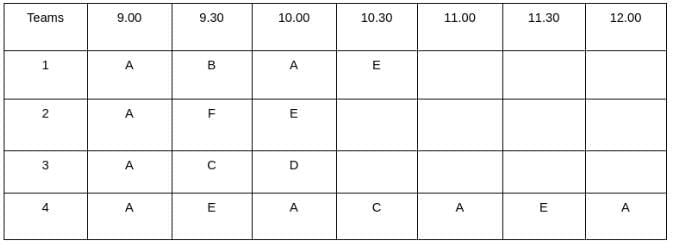
We can see that team 1 is at station E at 10:30 hrs, and they will reach station B at 11:30 hrs, which is only possible when they travel to B via A.
Hence, the complete route diagram for team 1 is (A - B - A - E - A - B - A). It is also known that Teams 1 and 3 are the only ones in station E at 10:30 hrs.
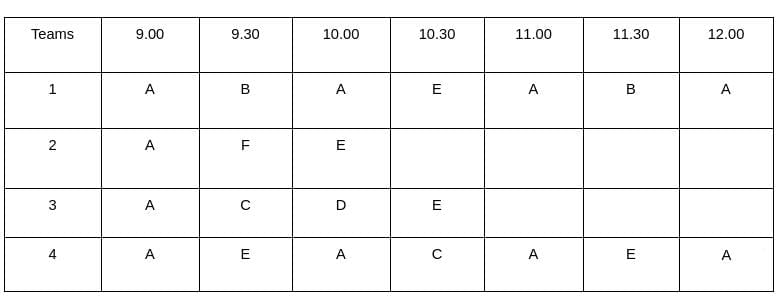
The only possible root for Team 2 at 10:00 hrs. is from E to F since they can't choose E to D because Team 3 is already on this route. Since team 3 has to reach A at 12:00. The only possible combination for team 3 is E - D - C - A
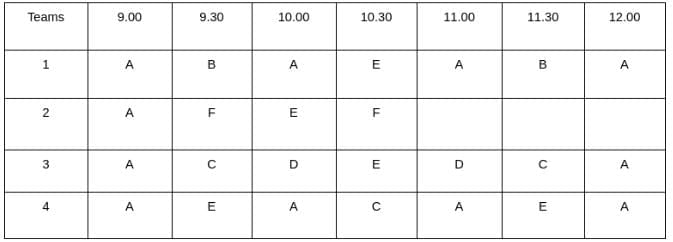
Now the routes for team 2 going back to A is from F at 10:30 hrs. (F - A - F - A) or (F - E - F - A).
Hence, the final table is given below:
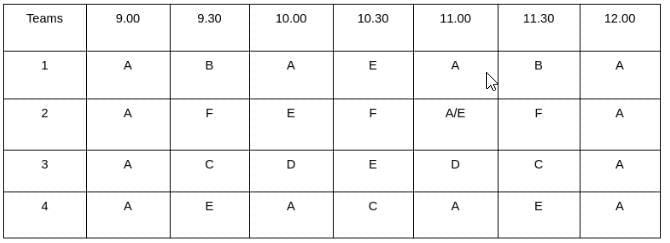
From the table, we can see that the teams have passed through B 2 times in this given period.
Q3: Which team patrols the street connecting Stations D and E at 10:15 hrs?
(a) Team 4
(b) Team 1
(c) Team 2
(d) Team 3
 View Answer
View Answer 
Ans: (d)
It is given that none of the streets has more than one team traveling along it in any direction at any point in time (point 1), which implies at 9:00 hrs, all 4 teams have chosen different routes from the starting point.
It is also known that Teams 2 and 3 are the only ones in stations E and D respectively at 10:00 hrs, and Team 1 and Team 4 are the only teams that patrol the street connecting stations A and E.
It is only possible when Team 2 traveled (A - E) via F, and Team 3 reached station D via station C.
It is also known that Teams 1 and 3 are the only ones in Station E at 10:30 hrs, and Team 4 never passes through Stations B, D, or F. Hence, Team 1 must have chosen the (A-B) route at the starting point, and Team 4 has chosen the (A - E) root at 9:00 hrs.
Hence, Team 1 will reach B at 9:30, and come to A at 10:00 hrs. After that, they will go to E at 10:30 hrs.
Since Team 4 never passes through stations B, D, or F. Team 4 only can pass through stations A, E, and C.
Hence, the routes of team 4 to reach station E at 11:30 will be (A - E - A - C - A - E) or (A - E - A - E - A - E).
Since team 1 is already traveling to E from A at 10:00 hrs, at that time team 4 can't choose the same route. Hence, the final route for team 4 to reach E at 11:30 is (A - E - A - C - A - E), and at 12:00 hrs, team 4 will come back to station A.
Hence, the complete route diagram for team 4 is (A - E - A - C - A - E - A)
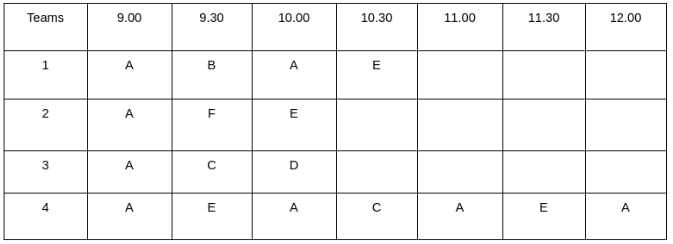
We can see that team 1 is at station E at 10:30 hrs, and they will reach station B at 11:30 hrs, which is only possible when they travel to B via A.
Hence, the complete route diagram for team 1 is (A - B - A - E - A - B - A). It is also known that Teams 1 and 3 are the only ones in station E at 10:30 hrs.
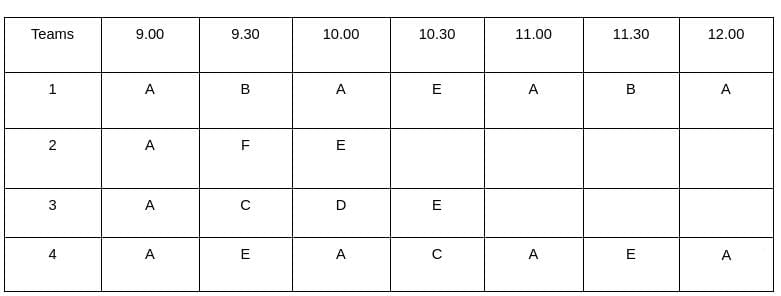
The only possible root for Team 2 at 10:00 hrs. is from E to F since they can't choose E to D because Team 3 is already on this route. Since team 3 has to reach A at 12:00. The only possible combination for team 3 is E - D - C - A
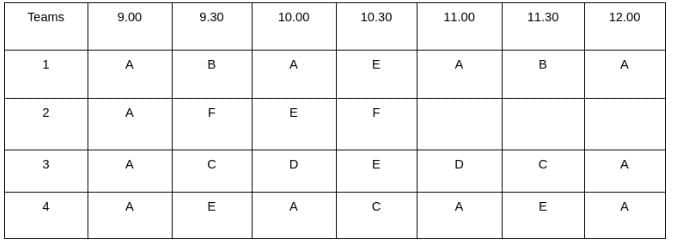
Now the routes for team 2 going back to A is from F at 10:30 hrs. (F - A - F - A) or (F - E - F - A).
Hence, the final table is given below:
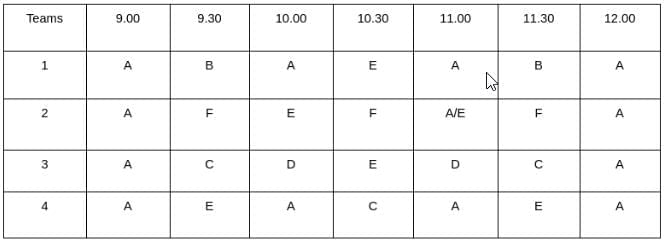
From the table, we can see that a 10.15 hrs, team 3 is travelling from station D to station E.
The correct option is D
Q4: How many times does Team 4 pass through Station E in a day?
 View Answer
View Answer 
Ans: 2
It is given that none of the streets has more than one team traveling along it in any direction at any point in time (point 1), which implies at 9:00 hrs, all 4 teams have chosen different routes from the starting point.
It is also known that Teams 2 and 3 are the only ones in stations E and D respectively at 10:00 hrs, and Team 1 and Team 4 are the only teams that patrol the street connecting stations A and E.
It is only possible when Team 2 traveled (A - E) via F, and Team 3 reached station D via station C.
It is also known that Teams 1 and 3 are the only ones in Station E at 10:30 hrs, and Team 4 never passes through Stations B, D, or F. Hence, Team 1 must have chosen the (A-B) route at the starting point, and Team 4 has chosen the (A - E) root at 9:00 hrs.
Hence, Team 1 will reach B at 9:30, and come to A at 10:00 hrs. After that, they will go to E at 10:30 hrs.
Since Team 4 never passes through stations B, D, or F. Team 4 only can pass through stations A, E, and C.
Hence, the routes of team 4 to reach station E at 11:30 will be (A - E - A - C - A - E) or (A - E - A - E - A - E).
Since team 1 is already traveling to E from A at 10:00 hrs, at that time team 4 can't choose the same route. Hence, the final route for team 4 to reach E at 11:30 is (A - E - A - C - A - E), and at 12:00 hrs, team 4 will come back to station A.
Hence, the complete route diagram for team 4 is (A - E - A - C - A - E - A)
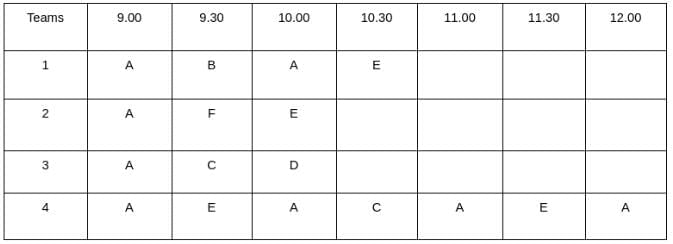
We can see that team 1 is at station E at 10:30 hrs, and they will reach station B at 11:30 hrs, which is only possible when they travel to B via A.
Hence, the complete route diagram for team 1 is (A - B - A - E - A - B - A). It is also known that Teams 1 and 3 are the only ones in station E at 10:30 hrs.
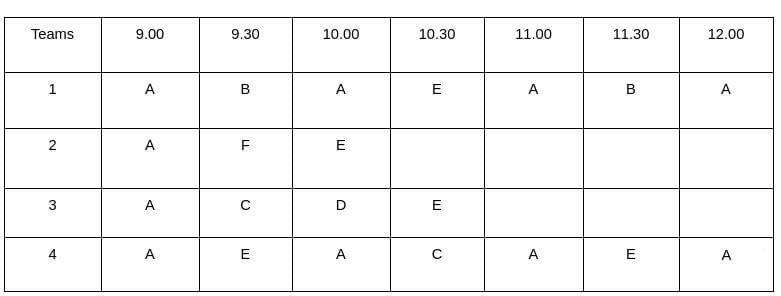
The only possible root for Team 2 at 10:00 hrs. is from E to F since they can't choose E to D because Team 3 is already on this route. Since team 3 has to reach A at 12:00. The only possible combination for team 3 is E - D - C - A
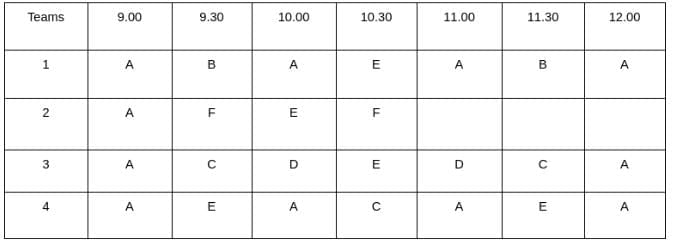
Now the routes for team 2 going back to A is from F at 10:30 hrs. (F - A - F - A) or (F - E - F - A).
Hence, the final table is given below:
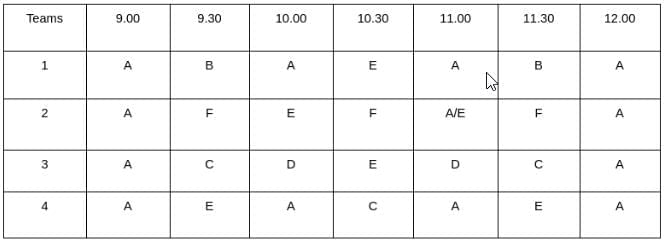 From the table, we can see that team 4 passed station E 2 times in a day
From the table, we can see that team 4 passed station E 2 times in a day
Q5: How many teams pass through Station C in a day?
(a) 4
(b) 3
(c) 1
(d) 2
 View Answer
View Answer 
Ans: (d)
It is given that none of the streets has more than one team traveling along it in any direction at any point in time (point 1), which implies at 9:00 hrs, all 4 teams have chosen different routes from the starting point.
It is also known that Teams 2 and 3 are the only ones in stations E and D respectively at 10:00 hrs, and Team 1 and Team 4 are the only teams that patrol the street connecting stations A and E.
It is only possible when Team 2 traveled (A - E) via F, and Team 3 reached station D via station C.
It is also known that Teams 1 and 3 are the only ones in Station E at 10:30 hrs, and Team 4 never passes through Stations B, D, or F. Hence, Team 1 must have chosen the (A-B) route at the starting point, and Team 4 has chosen the (A - E) root at 9:00 hrs.
Hence, Team 1 will reach B at 9:30, and come to A at 10:00 hrs. After that, they will go to E at 10:30 hrs.
Since Team 4 never passes through stations B, D, or F. Team 4 only can pass through stations A, E, and C.
Hence, the routes of team 4 to reach station E at 11:30 will be (A - E - A - C - A - E) or (A - E - A - E - A - E).
Since team 1 is already traveling to E from A at 10:00 hrs, at that time team 4 can't choose the same route. Hence, the final route for team 4 to reach E at 11:30 is (A - E - A - C - A - E), and at 12:00 hrs, team 4 will come back to station A.
Hence, the complete route diagram for team 4 is (A - E - A - C - A - E - A)
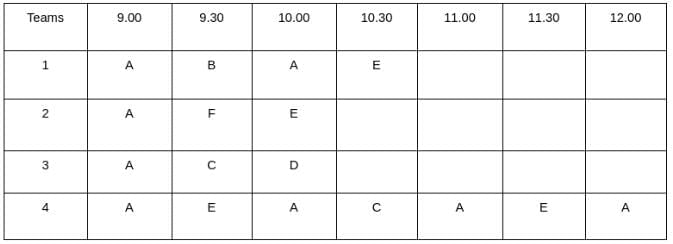
We can see that team 1 is at station E at 10:30 hrs, and they will reach station B at 11:30 hrs, which is only possible when they travel to B via A.
Hence, the complete route diagram for team 1 is (A - B - A - E - A - B - A). It is also known that Teams 1 and 3 are the only ones in station E at 10:30 hrs.
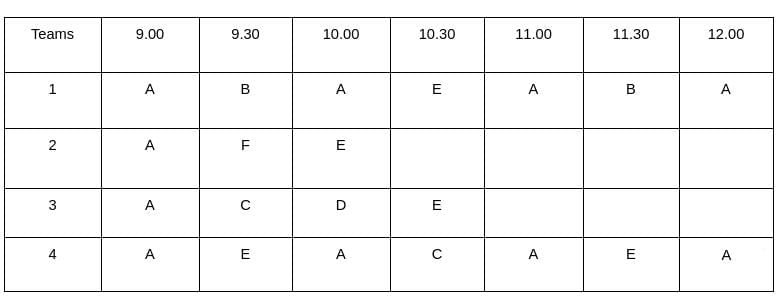
The only possible root for Team 2 at 10:00 hrs. is from E to F since they can't choose E to D because Team 3 is already on this route. Since team 3 has to reach A at 12:00. The only possible combination for team 3 is E - D - C - A
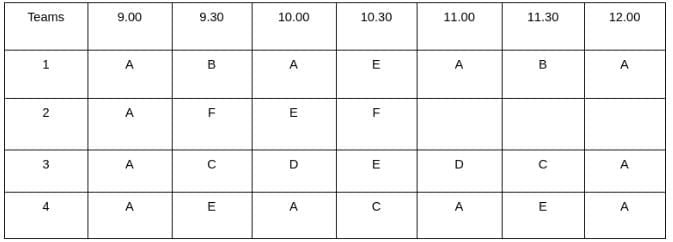
Now the routes for team 2 going back to A is from F at 10:30 hrs. (F - A - F - A) or (F - E - F - A).
Hence, the final table is given below:
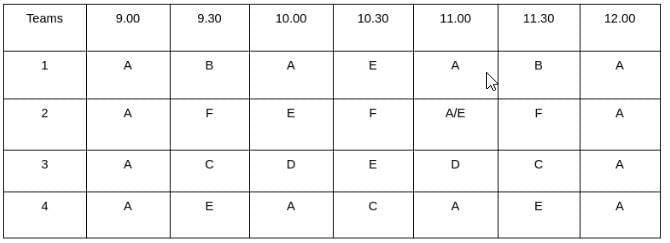 From the table, we can see that 2 teams (teams 3 and 4) have passed through station C on the given day.
From the table, we can see that 2 teams (teams 3 and 4) have passed through station C on the given day.
The correct option is D.
|
102 videos|123 docs|121 tests
|
FAQs on Practice Question - 77 (Scheduling) - 100 DILR Questions for CAT Preparation
| 1. What is the significance of scheduling in the context of examinations? |  |
| 2. How can students effectively manage their study schedules for examinations? |  |
| 3. What are common challenges faced in examination scheduling? |  |
| 4. What strategies can examination authorities employ to improve scheduling efficiency? |  |
| 5. Why is it important to consider student feedback when scheduling exams? |  |




















